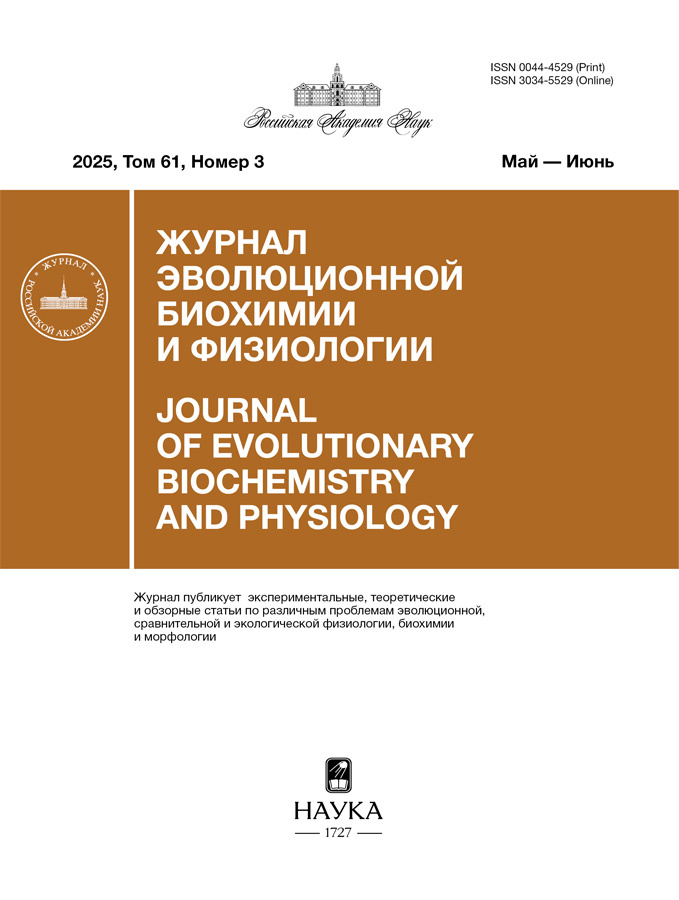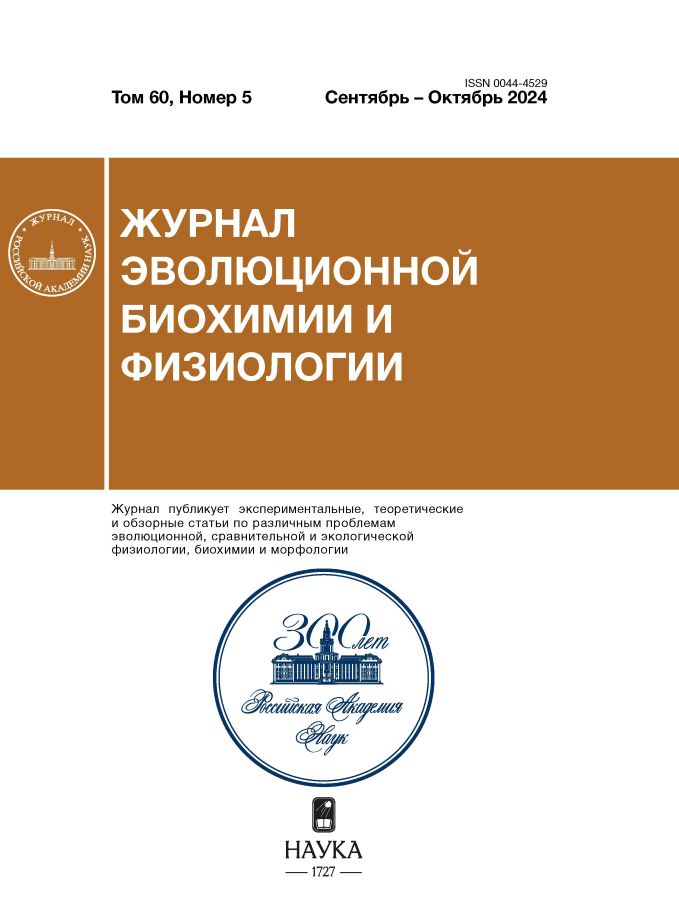Сравнительное исследование температурного коэффициента Q10 гибернирующих сусликов Urocitellus undulatus и охлажденных крыс разного возраста
- Авторы: Захарова Н.М.1, Тараховский Ю.С.1,2, Хренов М.О.1
-
Учреждения:
- Институт биофизики клетки РАН
- Институт теоретической и экспериментальной биофизики РАН
- Выпуск: Том 60, № 5 (2024)
- Страницы: 499-508
- Раздел: ЭКСПЕРИМЕНТАЛЬНЫЕ СТАТЬИ
- URL: https://rjeid.com/0044-4529/article/view/648101
- DOI: https://doi.org/10.31857/S0044452924050045
- EDN: https://elibrary.ru/XPMDWF
- ID: 648101
Цитировать
Полный текст
Аннотация
Проведен анализ температурного коэффициента Q10 частоты сердечных сокращений (Q10HR) и потребления кислорода (Q10Ox) при пробуждении длиннохвостых сусликов Urocitellus undulatus, а также при отогревании предварительно охлажденных взрослых крыс и крысят. Величину Q10Ox вычисляли по стандартной формуле, тогда как для вычисления Q10HR формула была эмпирически модифицирована для отслеживания изменений этого параметра в широком диапазоне температур тела (Tb). Установлено, что у сусликов в начальный период выхода из спячки, при Tb ≤ 10 ℃, наблюдались высокие значения температурных коэффициентов Q10HR = 40 – 50 и Q10Ox = 6 – 7. Еще более высокие значения Q10HR > 100 были обнаружены в начале отогревания крысят, хотя у них был низкий уровень Q10Ox = 1.2. Взрослые крысы не выдерживали охлаждения ниже 16 ℃ и демонстрировали умеренную вариабельность как Q10HR = 2.0 – 4.0, так и Q10Ox = 2.0 – 2.2. В процессе восстановления нормальной Tb значения Q10HR у всех животных приближались к величине ~2.0, предсказанной правилом Вант Гоффа-Аррениуса для химических реакций в живой и неживой природе. Мы предполагаем, что высокие значения Q10HR и Q10Ox, обнаруженные в ранний период выхода сусликов из гибернации, могут свидетельствовать о функционировании адаптационных механизмов, направленных на ускорение согревания тела. Устойчивость к охлаждению и высокий коэффициент Q10HR у крысят, как представителей отряда Rodentia, к которому относятся также естественные гибернаторы — суслики, могут свидетельствовать о функционировании в ювенальный период крыс рудиментарных механизмов адаптации к охлаждению и гетеротермии.
Ключевые слова
Полный текст
Об авторах
Н. М. Захарова
Институт биофизики клетки РАН
Автор, ответственный за переписку.
Email: n_m_zakharova@pbcras.ru
Россия, Пущино
Ю. С. Тараховский
Институт биофизики клетки РАН; Институт теоретической и экспериментальной биофизики РАН
Email: tarahov@rambler.ru
Россия, Пущино; Пущино
М. О. Хренов
Институт биофизики клетки РАН
Email: n_m_zakharova@pbcras.ru
Россия, Пущино
Список литературы
- Tansey EA, Johnson CD (2015) Recent advances in thermoregulation. Adv Physiol Ed 39:139–148. https://doi.org/10.1152/advan.00126.2014
- Horii Y, Shiina T, Shimizu Y (2018) The Mechanism Enabling Hibernation in Mammals. Adv Exp Med Biol 1081:45–60. https://doi.org/10.1007/978-981-13-1244-1_3
- Ivanov KP (2000) Physiological blocking of the mechanisms of cold death: theoretical and experimental considerations. J Thermal Biol 25:467–479. https://doi.org/10.1016/s0306-4565(00)00012-7
- Carey HV, Andrews MT, Martin SL (2003) Mammalian Hibernation: Cellular and Molecular Responses to Depressed Metabolism and Low Temperature. Physiol Rev 83:1153–1181. https://doi.org/10.1152/physrev.00008.2003
- Ruf T, Geiser F (2014) Daily torpor and hibernation in birds and mammals. Biol Rev 90:891–926. https://doi.org/10.1111/brv.12137
- Davidson JO, Wassink G, van den Heuij LG, Bennet L, Gunn AJ (2015) Therapeutic Hypothermia for Neonatal Hypoxic-Ischemic Encephalopathy — Where to from Here? Front Neurol 6:198. https://doi.org/10.3389/fneur.2015.00198
- Han Z, Liu X, Luo Y, Ji Х (2015) Therapeutic hypothermia for stroke: Where to go? Experimental Neurology 272:67–77. https://doi.org/10.1016/j.expneurol.2015.06.006
- Huang F-Y, Huang B-T, Wang P-J, Zuo Z-L, Heng Y, Xia T-L, Gui Y-Y, Lv W-Y, Zhang C, Liao Y-B, Liu W, Chen M, Zhu Y (2015) The efficacy and safety of prehospital therapeutic hypothermia in patients with out-of-hospital cardiac arrest: A systematic review and meta-analysis. Resuscitation 96:170–179. https://doi.org/10.1016/j.resuscitation.2015.08.005
- Otto KA (2015) Therapeutic hypothermia applicable to cardiac surgery. Vet Anaesth Analg 42:559–569. https://doi.org/10.1111/vaa.12299
- Cerri M, Hitrec T, Luppi M, Amici R (2021) Be cool to be far: Exploiting hibernation for space exploration. Neurosci Biobehav Rev 128:218–232. https://doi.org/10.1016/j.neubiorev.2021.03.037
- Choukèr (2018) Hibernating astronauts-science or fiction? Pflueg. Arch. Eur. J. Physiol.
- Zakharova NM, Tarahovsky YS, Komelina NP, Fadeeva IS, Kovtun AL (2021) Long-term pharmacological torpor of rats with feedback-controlled drug administration. Life Sci Space Res 28:18–21. https://doi.org/10.1016/j.lssr.2020.11.002
- Kornhall DK, Martens-Nielsen J (2016) The prehospital management of avalanche victims. J R Army Med Corps 162:406–412. https://doi.org/10.1136/jramc-2015-000441
- Sward DG, Bennett BL (2014) Wilderness medicine. World J Emerg Med 5:5–15. https://doi.org/10.5847/wjem.j.issn.1920-8642.2014.01.001
- Alam HB (2012) Translational barriers and opportunities for emergency preservation and resuscitation in severe injuries. Br J Surg 99 Suppl 1:29–39. https://doi.org/10.1002/bjs.7756
- Tarahovsky YS, Khrenov MO, Kovtun AL, Zakharova NM (2020) Comparison of natural and pharmacological hypothermia in animals: Determination of activation energy of metabolism. Journal of Thermal Biology 92:102658. https://doi.org/10.1016/j.jtherbio.2020.102658
- Zakharova NM, Tarahovsky YS, Fadeeva IS, Zakharova NM (2019) A pharmacological composition for induction of a reversible torpor-like state and hypothermia in rats. Life Sci 219:190–198. https://doi.org/10.1016/j.lfs.2019.01.023
- Shimaoka H, Shiina T, Suzuki H, Horii Y, Horii K, Shimizu Y (2021) Successful induction of deep hypothermia by isoflurane anesthesia and cooling in a non-hibernator, the rat. J Physiol Sci 71:10. https://doi.org/10.1186/s12576-021-00794-1
- Yang Y, Yuan J, Field RL, Ye D, Hu Z, Xu K, Xu L, Gong Y, Yue Y, Kravitz AV, Bruchas MR, Cui J, Brestoff JR, Chen H (2023) Induction of a torpor-like hypothermic and hypometabolic state in rodents by ultrasound. Nat Metab 5:789–803. https://doi.org/10.1038/s42255-023-00804-z
- Bridwell RE, Willis GC, Gottlieb M, Koyfman A, Long B (2021) Decompensated hypothyroidism: A review for the emergency clinician. Am J Emerg Med 39:207–212. https://doi.org/10.1016/j.ajem.2020.09.062
- Naito H, Nojima T, Fujisaki N, Tsukahara K, Yamamoto H, Yamada T, Aokage T, Yumoto T, Osako T, Nakao A (2020) Therapeutic strategies for ischemia reperfusion injury in emergency medicine. Acute Med Surg 7:e501. https://doi.org/10.1002/ams2.501
- Zakharova NM, Tarahovsky YS, Komelina NP, Khrenov MO, Kovtun AL (2021) Pharmacological torpor prolongs rat survival in lethal normobaric hypoxia. J Thermal Biol 98:102906. https://doi.org/10.1016/j.jtherbio.2021.102906
- Bejaoui M, Pantazi E, Folch-Puy E, Baptista PM, García-Gil A, Adam R, Roselló-Catafau J (2015) Emerging concepts in liver graft preservation. World J Gastroenterol 21:396–407. https://doi.org/10.3748/wjg.v21.i2.396
- Minor T, Paul A (2013) Hypothermic reconditioning in organ transplantation. Curr Opin Organ Transplant 18:161–167. https://doi.org/10.1097/MOT.0b013e32835e29de
- Søreide K (2014) Clinical and translational aspects of hypothermia in major trauma patients: from pathophysiology to prevention, prognosis and potential preservation. Injury 45:647–654. https://doi.org/10.1016/j.injury.2012.12.027
- Soo E, Welch A, Marsh C, McKay D (2020) Molecular strategies used by hibernators: Potential therapeutic directions for ischemia reperfusion injury and preservation of human donor organs. Transplantat Rev 34:100512. https://doi.org/10.1016/j.trre.2019.100512
- Kang K (2016) Exceptionally high thermal sensitivity of rattlesnake TRPA1 correlates with peak current amplitude. Biochim Biophys Acta 1858:318–325. https://doi.org/10.1016/j.bbamem.2015.12.011
- Hiebert SM, Noveral J (2007) Are chicken embryos endotherms or ectotherms? A laboratory exercise integrating concepts in thermoregulation and metabolism. Adv Physiol Educ 31:97–109. https://doi.org/10.1152/advan.00035.2006
- Schmidt-Nielsen K (1990) Animal physiology: Adaptation and environment, 4th ed. Cambridge University Press, Cambridge, New York
- Geiser F (2016) Conserving energy during hibernation. J Exp Biol 219:2086–2087. https://doi.org/10.1242/jeb.129171
- Geiser F (2004) Metabolic Rate and Body Temperature Reduction During Hibernation and Daily Torpor. Ann Rev Physiol 66:239–274. https://doi.org/10.1146/annurev.physiol.66.032102.115105
- Kampmann B, Bröde P (2019) Heat Acclimation Does Not Modify Q10 and Thermal Cardiac Reactivity. Front Physiol 10:1524. https://doi.org/10.3389/fphys.2019.01524
- Currie SE, Noy K, Geiser F (2015) Passive rewarming from torpor in hibernating bats: minimizing metabolic costs and cardiac demands. Am J Physiol Regul Integr Comp Physiol 308:R34–41. https://doi.org/10.1152/ajpregu.00341.2014
- Bröde P, Kampmann B (2018) Accuracy of metabolic rate estimates from heart rate under heat stress—an empirical validation study concerning ISO 8996. Ind Health 57:615–620. https://doi.org/10.2486/indhealth.2018-0204
- Kampmann B, Bröde P (2015) Metabolic costs of physiological heat stress responses — Q10 coefficients relating oxygen consumption to body temperature. Extrem Physiol Med 4:A103. https://doi.org/10.1186/2046-7648-4-S1-A103
- Michenfelder JD, Milde JH (1991) The relationship among canine brain temperature, metabolism, and function during hypothermia. Anesthesiology 75:130–136. https://doi.org/10.1097/00000542-199107000-00021
- Song X, Körtner G, Geiser F (1997) Thermal relations of metabolic rate reduction in a hibernating marsupial. Am J Physiol 273:R2097-104. https://doi.org/10.1152/ajpregu.1997.273.6.R2097
- Liu B, Hui K, Qin F (2003) Thermodynamics of Heat Activation of Single Capsaicin Ion Channels VR1. Biophysical Journal 85:2988–3006.
- Fohlmeister JF (2015) Voltage gating by molecular subunits of Na+ and K+ ion channels: higher-dimensional cubic kinetics, rate constants, and temperature. J Neurophysiol 113:3759–3777. https://doi.org/10.1152/jn.00551.2014
- Andjus RK, Smith AU (1954) Revival of hypothermic rats after arrest of circulation and respiration. J Physiol 123:66P-67P.
- Andjus RK, Smith AU (1955) Reanimation of adult rats from body temperatures between 0 and + 2 degrees C. J Physiol 128:446–472. https://doi.org/10.1113/jphysiol.1955.sp005318
- Andjus RK, Dzakula Z, Markley JL, Macura S (2005) Brain energetics and tolerance to anoxia in deep hypothermia. Ann N Y Acad Sci 1048:10–35. https://doi.org/10.1196/annals.1342.003
- Lomako VV, Shilo AV (2009) Effect of General Cooling on Rat Behaviour in "Open Field" Test. Probl Cryobiol 19:421–430.
- Bullard RW, Funkhouser GE (1962) Estimated regional blood flow by rubidium 86 distribution during arousal from hibernation. Am J Physiology-Legacy Content 203:266–270. https://doi.org/10.1152/ajplegacy.1962.203.2.266
- Zakharova NM (2014) Some features of body warming at provoked awakening of hibernating ground squirrels Spermophilus undulatus. Fundamental Res 6:1401–1405. (In Russ).
- Mundim KC, Baraldi S, Machado HG, Vieira FMC (2020) Temperature coefficient (Q10) and its applications in biological systems: Beyond the Arrhenius theory. Ecol Model 431:109127. https://doi.org/10.1016/j.ecolmodel.2020.109127
- Rogalska J, Caputa M (2005) Spontaneously reduced body temperature and gasping ability as a mechanism of extreme tolerance to asphyxia in neonatal rats. J Thermal Biol 30:360–369. https://doi.org/10.1016/j.jtherbio.2005.02.003
- Kletkiewicz H, Rogalska J, Nowakowska A (2016) Effects of body temperature on post-anoxic oxidative stress from the perspective of postnatal physiological adaptive processes in rats. J Physiol Pharmacol 67:287–299.
- Geiser F, Currie SE, O'Shea KA, Hiebert SM (2014) Torpor and hypothermia: reversed hysteresis of metabolic rate and body temperature. Am J Physiol-Regul, Integrat Comparat Physiol 307:R1324-R1329. https://doi.org/10.1152/ajpregu.00214.2014
- Lyman CP, Williams JS, Malan A, Wang LCH (1984) Hibernation and torpor in mammals and birds. Academic Press, New York.
- Zanetti F, Chen C-Y, Baker HA, Sugiura MH, Drew KL, Barati Z (2023) Cardiac Rhythms and Variation in Hibernating Arctic Ground Squirrels. Physiol Biochem Zool 96:167–176. https://doi.org/10.1086/724688
- MacCannell ADV, Jackson EC, Mathers KE, Staples JF (2018) An improved method for detecting torpor entrance and arousal in a mammalian hibernator using heart rate data. J Exp Biol 221. https://doi.org/10.1242/jeb.174508
- Milsom WK, Zimmer MB, Harris MB (1999) Regulation of cardiac rhythm in hibernating mammals. Com Biochem Physiol Part A: Mol & Integrat Physiol 124:383–391. https://doi.org/10.1016/s1095-6433(99)00130-0
- Shinde AB, Song A, Wang QA (2021) Brown Adipose Tissue Heterogeneity, Energy Metabolism, and Beyond. Front Endocrinol 12:651763. https://doi.org/10.3389/fendo.2021.651763
- Nedergaard J, Cannon B (2018) Brown adipose tissue as a heat-producing thermoeffector. http://dx.doi.org/10.1016/B978-0-444-63912-7.00009-6
- Shimaoka H, Kawaguchi T, Morikawa K, Y Sano, K Naitou, H Nakamori, T Shiina, Y Shimizu (2017) Induction of hibernation-like hypothermia by central activation of the A1 adenosine receptor in a non-hibernator, the rat. J Physiol Sci 68:425–430. https://doi.org/10.1007/s12576-017-0543-y
- Nowack J, Turbill C (2022) Survivable hypothermia or torpor in a wild-living rat: rare insights broaden our understanding of endothermic physiology. J Comp Physiol B 192:183–192. https://doi.org/10.1007/s00360-021-01416-3
Дополнительные файлы













